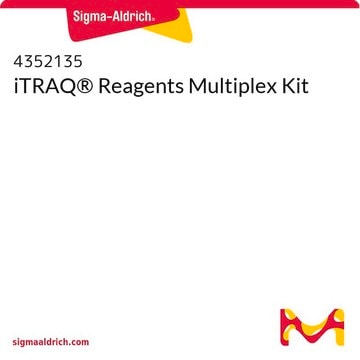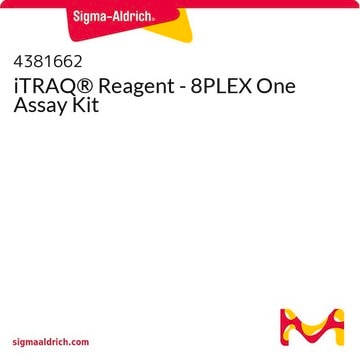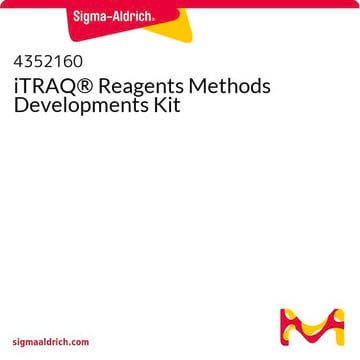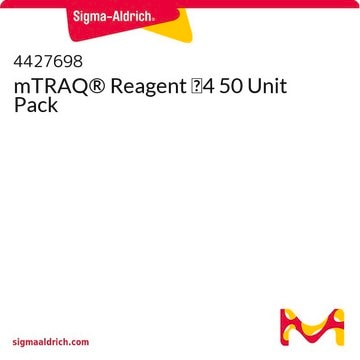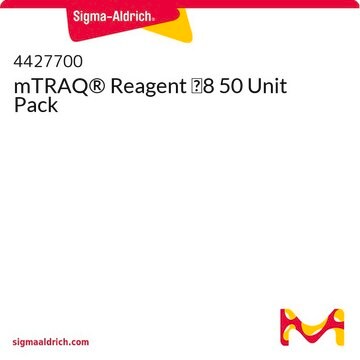4381664
iTRAQ® Reagent - Multiplex Buffer Kit
Sinónimos:
isobaric tags for relative and absolute quantitation, buffer kit
Iniciar sesiónpara Ver la Fijación de precios por contrato y de la organización
About This Item
UNSPSC Code:
12161503
NACRES:
NA.25
Productos recomendados
shipped in
dry ice
storage temp.
−20°C
General description
Contains SDS – Denaturant, TCEP Reducing Reagent, MMTS Cysteine Blocking Reagent, TEAB Buffer and Isopropanol, sufficient material for either two 8-plex Multiplex Kits, three 4-plex Kits, or four mTRAQ® 10 Assay Kits.
The iTRAQ® Reagents are a set of isobaric, multiplexed, amine-specific, stable-isotope reagents that can label all peptides in up to eight different biological samples at the same time, allowing for simultaneous identification and quantitation, both relative and absolute, while preserving important post-translational modification (PTM) information. The iTRAQ® reagents can be used to study the differential expression of proteins in perturbed systems.
Application
iTRAQ® Reagent - Multiplex Buffer Kit has been used in the isobaric tag for relative and absolute quantitation (iTRAQ) labeling of protein samples.
Analysis Note
To view the Chemistry Quick Reference Card for the iTRAQ® Reagents, please visit this Chemistry Quick Reference Card link.
Legal Information
MTraq is a registered trademark of AB Sciex Pte. Ltd.
iTraq is a registered trademark of AB Sciex Pte. Ltd.
signalword
Danger
hcodes
Hazard Classifications
Eye Irrit. 2 - Flam. Liq. 2 - Skin Irrit. 2 - STOT SE 3
target_organs
Central nervous system
Storage Class
3 - Flammable liquids
flash_point_f
53.6 °F - closed cup
flash_point_c
12.0 °C - closed cup
Certificados de análisis (COA)
Busque Certificados de análisis (COA) introduciendo el número de lote del producto. Los números de lote se encuentran en la etiqueta del producto después de las palabras «Lot» o «Batch»
¿Ya tiene este producto?
Encuentre la documentación para los productos que ha comprado recientemente en la Biblioteca de documentos.
Los clientes también vieron
Lynn R Zieske
Journal of experimental botany, 57(7), 1501-1508 (2006-04-01)
Proteomic research includes the characterization of protein mixtures in order to understand complex biological systems and determine relationships between proteins, their function, and protein-protein interactions. Often the goal of such research is to monitor changes of proteins in perturbed systems
Hongmei Lu et al.
Clinical proteomics, 16, 33-33 (2019-08-07)
Diabetic nephropathy is the most frequent cause of end-stage renal disease worldwide. Identification of biomarkers for diabetic nephropathy for early diagnosis may be the key to avoiding damage from this condition. Proteomic iTRAQ technology was first used to identify differentially
Xiangyu Deng et al.
MicrobiologyOpen, 9(5), e1012-e1012 (2020-02-29)
β-Glucosidase production by Aspergillus niger is accompanied by an inevitable temperature increase in the industrial fermentation environment. Hence, the synthetic process of β-glucosidase is negatively affected. However, our understanding of the heat stress response (HSR) mechanism in A. niger is still
Kening Li et al.
Evidence-based complementary and alternative medicine : eCAM, 2019, 5107198-5107198 (2019-06-22)
NaoMaiTong (NMT) is widely used in the treatment of cerebral ischemia but the molecular details of its beneficial effects remain poorly characterized. In this study, we used iTRAQ using 2D LC-MS/MS technology to investigate the cellular mechanisms governing the protective
Juan Du et al.
FEBS letters, 592(22), 3736-3749 (2018-10-13)
Circadian clocks control daily rhythms in physiology, metabolism and behaviour in most organisms. Proteome-wide analysis of protein oscillations is still lacking in Drosophila. In this study, the total protein and phosphorylated protein in Drosophila heads in a 24-h daily time-course
Nuestro equipo de científicos tiene experiencia en todas las áreas de investigación: Ciencias de la vida, Ciencia de los materiales, Síntesis química, Cromatografía, Analítica y muchas otras.
Póngase en contacto con el Servicio técnico
